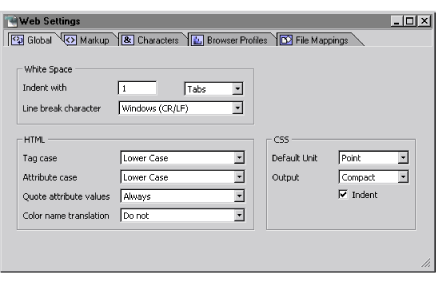 |
Using the Global tab
- Macintosh (CR) inserts a carriage return character only.
- Unix (LF) inserts a line feed character only.
- Windows (CR/LF) inserts a carriage return and line feed character combination.
- Upper Case uses only uppercase characters in the tag or attribute name.
- Lower Case uses only lowercase characters in tags or attributes.
- Capital capitalizes the first letter of each tag or attribute name.
- Database Driven writes the tag or attribute as specified in the Markup tab of Web Settings.
- Always inserts quotation marks around all attribute values, for example, <IMG SRC="logo.gif">.
- Except Numbers encloses all attribute values, except for numerals, for example, <IMG SRC="logo.gif" width=50>.
- Only if Necessary inserts quotation marks if there is a risk of ambiguity.
- Do Not uses hexadecimal RGB values, for example, "#000000" for "Black".
- 16 Basics uses the color names for sixteen basic colors, such as "purple" for the hexadecimal value "#800080", and uses the hexadecimal value for all other colors.
- Netscapes uses the Netscape-specific color names for certain RGB color values, such as "Lime" for the RGB value "0, 255, 0," and uses the hexadecimal value for all other colors.
The Global tab ![]() of the Web Settings window contains options for formatting the source code, such as indentation, and lowercase and uppercase usage. You can preview most changes you make to the Global panel options in the Source Code palette.
of the Web Settings window contains options for formatting the source code, such as indentation, and lowercase and uppercase usage. You can preview most changes you make to the Global panel options in the Source Code palette.

You can set options relating to white space, HTML code, and cascading style sheets:
Indent with:
Sets the indentation value and the type of indentation between sets of container tags in the source code.
Line break character:
Specifies how line breaks are written for your Web server platform:
Tag case, Attribute case:
Specifies how HTML tags or attributes are written.
Quote attribute values:
Determines whether values for HTML tag attributes are enclosed in straight quotation marks:
Color name translation:
Determines whether color values are written using color names:
Default Unit:
Specifies the default unit used in Cascading Style Sheets (CSS).
Output:
Determines the spatial format used to arrange CSS source code.
Indent:
Specifies whether CSS source code is indented.